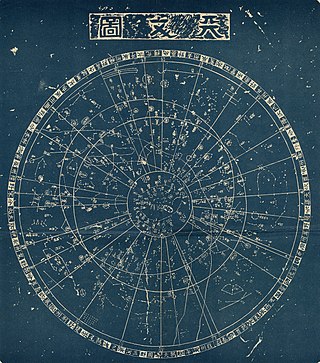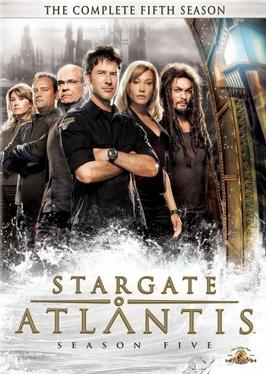
Stargate is a 1994 science fiction adventure film directed and co-written by Roland Emmerich. The film is the first entry in the Stargate media franchise and stars Kurt Russell, James Spader, Jaye Davidson, Alexis Cruz, Mili Avital, and Viveca Lindfors. The plot centers on the premise of a "Stargate", an ancient ring-shaped device that creates a wormhole, enabling travel to a similar device elsewhere in the universe. The film's central plot explores the theory of extraterrestrial beings having an influence upon human civilization.

Ursa Major is a constellation in the northern sky, whose associated mythology likely dates back into prehistory. Its Latin name means "greater bear", referring to and contrasting it with nearby Ursa Minor, the lesser bear. In antiquity, it was one of the original 48 constellations listed by Ptolemy in the 2nd century AD, drawing on earlier works by Greek, Egyptian, Babylonian, and Assyrian astronomers. Today it is the third largest of the 88 modern constellations.

Traditional Chinese astronomy has a system of dividing the celestial sphere into asterisms or constellations, known as "officials".

Michael Garrett Shanks is a Canadian actor. He is best known for his role as Daniel Jackson in the long-running military science fiction television series Stargate SG-1 and as Charles Harris in the Canadian medical drama Saving Hope. He is also known for his work on low budget genre work filmed in Canada.
Stargate Atlantis is an adventure and military science fiction television series and part of MGM's Stargate franchise. The show was created by Brad Wright and Robert C. Cooper as a spin-off series of Stargate SG-1, which was created by Wright and Jonathan Glassner and was itself based on the feature film Stargate (1994). All five seasons of Stargate Atlantis were broadcast by the Sci-Fi Channel in the United States and The Movie Network in Canada. The show premiered on July 16, 2004; its final episode aired on January 9, 2009. The series was filmed in and around Vancouver, British Columbia, Canada.
Stargate is a military science fiction media franchise based on the film directed by Roland Emmerich, which he co-wrote with producer Dean Devlin. The franchise is based on the idea of an alien wormhole device that enables nearly instantaneous travel across the cosmos. The franchise began with the film Stargate, released on October 28, 1994, by Metro-Goldwyn-Mayer and Carolco, which grossed US$197 million worldwide. In 1997, Brad Wright and Jonathan Glassner created a television series titled Stargate SG-1 as a sequel to the film. This show was joined by Stargate Atlantis in 2004, Stargate Universe in 2009, and a prequel web series, Stargate Origins, in 2018. Also consistent with the same story are a variety of books, video games and comic books, as well as the direct-to-DVD movies Stargate: Children of the Gods, Stargate: The Ark of Truth, and Stargate: Continuum, which concluded the first television show after 10 seasons.

An asterism is an observed pattern or group of stars in the sky. Asterisms can be any identified pattern or group of stars, and therefore are a more general concept than the 88 formally defined constellations. Constellations are based on asterisms, but unlike asterisms, constellations outline and today completely divide the sky and all its celestial objects into regions around their central asterisms. For example, the asterism known as the Big Dipper comprises the seven brightest stars in the constellation Ursa Major. Another is the asterism of the Southern Cross, within the constellation of Crux.

Orion's Belt or the Belt of Orion, also known as the Three Kings or Three Sisters, is an asterism in the constellation Orion. It consists of the three bright stars Alnitak, Alnilam and Mintaka.

Stargatefandom is a community of people actively interested in the military science fiction film Stargate and its television shows including Stargate SG-1 (SG1), Stargate Infinity (SGI), Stargate Atlantis (SGA), Stargate Universe (SGU) and their spin offs. The first franchise release, Stargate (1994) spawned four television series successors, four movies, a plethora of merchandise, and a massive franchise collectively known as the Stargate.

Phi Andromedae is the Bayer designation for a binary star system near the border of the northern constellation of Andromeda. This system has a combined apparent visual magnitude of 4.25 and is visible to the naked eye. Based upon parallax measurements made during the Hipparcos mission, this star system is located at a distance of about 720 light-years from Earth. With χ And it forms the Chinese asterism 軍南門, "the South Gate of the Camp".

The Big Dipper or the Plough is a large asterism consisting of seven bright stars of the constellation Ursa Major; six of them are of second magnitude and one, Megrez (δ), of third magnitude. Four define a "bowl" or "body" and three define a "handle" or "head". It is recognized as a distinct grouping in many cultures. The North Star (Polaris), the current northern pole star and the tip of the handle of the Little Dipper, can be located by extending an imaginary line through the front two stars of the asterism, Merak (β) and Dubhe (α). This makes it useful in celestial navigation.

A Dog's Breakfast is a Canadian comedy independent film produced in 2006. It was the first film to be written and directed by British-born Canadian actor David Hewlett, who is best known for his role of Dr. Rodney McKay in the TV franchise Stargate. Hewlett created the film as a private off-season project and stars alongside his real-life sister Kate Hewlett and Stargate actors Paul McGillion, Christopher Judge and Rachel Luttrell. The film was produced by John Lenic and Jane Loughman.

Stargate Universe is a military science fiction drama television series and part of MGM's Stargate franchise. It follows the adventures of a present-day, multinational exploration team traveling on the Ancient spaceship Destiny several billion light years distant from the Milky Way Galaxy. They are now trying to figure out a way to return to Earth, while simultaneously trying to explore and to survive in their unknown area of the universe. The series, created by Brad Wright and Robert C. Cooper, premiered in the United States on Syfy on October 2, 2009. The series featured an ensemble cast and was primarily filmed in and around Vancouver, British Columbia, Canada. A second season of 20 episodes was announced by Syfy in December 2009.

The fifth and final season of the military science fiction television series Stargate Atlantis commenced airing on the Sci Fi Channel in the United States on July 11, 2008, concluded on the same channel on January 9, 2009, and contained 20 episodes. The show itself is a spin off of its sister show, Stargate SG-1. The season upgrades previous supporting characters cast members such as Richard Woolsey and Jennifer Keller. Amanda Tapping's character Samantha Carter was downgraded to recurring character in this season. The fifth and final season is about a military-science expedition team fighting against the Wraith from their base of operation, Atlantis. The Wraith primary goal is to gather a fleet to invade Atlantis and find their new "feeding ground", Earth.

The second and final season of Stargate Universe was announced by Syfy on December 13, 2009. Like the first season, the second season consisted of 20 episodes. The series was moved from the franchise's long history of Friday to Tuesday, along with Caprica, as Syfy had picked up WWE Friday Night SmackDown. The series resumed on September 28, 2009, USA. In Ireland & UK, the series resumed on October 5 at 9pm on Sky1 and Sky1 HD.

Stargate is a 1994 platform game by Acclaim Entertainment for the Super Nintendo Entertainment System and Sega Genesis/Mega Drive. It follows the adventures of Colonel Jack O'Neil as he struggles to free the slaves of Abydos, defeat Ra, and get his mission team back home using the stargate device. The game is based on the 1994 film of the same name.

NGC 358 is an asterism of four stars in the constellation of Cassiopeia. Two of the members were found to have a similar distance of roughly 1700 light years with Hipparcos data, although the other two did not have well-constrained distances, so its exact nature was uncertain.
















